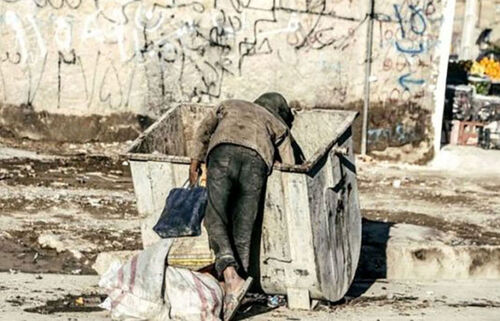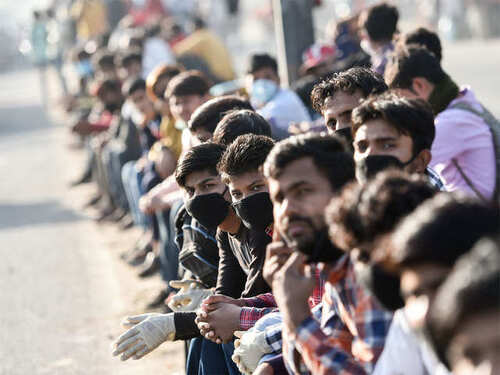The annual misery index and the unemployment rate of each region are measured in a given period of time. The misery index is a measuring scale to give us an understanding of the economic concerns that can be seen due to an increase in the unemployment statistics and as a result the destruction of people's lives. In other words, the percentage of seasonal unemployment is measured by the annual inflation rate. Since both unemployment and inflation are harmful to economic prosperity, the unification of these two is seen as an indicator of the health of the country's general economy.

Misery, a reason for committing crimes
With the increase of inflation and the rise of the poverty line in Iran, the shadow of misery index has covered most of the provinces in this country. Among those provinces with the highest misery index, the border provinces are the worst. The provinces that protested after the rise in the gasoline process in 2018 as well as last year's protests and were oppressed by the government most severely were among the areas with the highest misery index. The rising unemployment rate has caused the people of the East part of Kurdistan which has a common border with Iraq and the Kurdistan Region to become Kolbars and smuggle equipment and goods which is a dangerous task with many people dying every year.
Along with the rise in inflation, the situation of social care in Iran has worsened over the past five years. The official statistics show that the misery index has reached 57.7% in 2023 from 19.3% in 2015. The economists believe that the rise of the misery index will end in an increase in social damages such as crimes, poverty, suicide, declining population growth, and divorce; a risk that has spread in Iran for a decade now.

"Misery index" in Iran has been estimated to be 54.8% in 2022. The highest rate of this measure was in the Lorestan, Kermashan, and Sna provinces which are all located in the Zagros region. Provincial statistics show that the highest percentage of misery index is in Lorestan with 67.2%, Kermashan with 64.4%, and Sna with 63.7%. In these provinces, the rate of unemployment is at least 3 to 4 percent more than the average unemployment rate in Iran and the inflation in these areas is 50 percent more than the average of the country.
In general, the misery index in Iran has increased about 1.7 percent compared to last year which indicates the terrible economic situation of the people. Lorestan is among the first victims of underground water transference. In addition to global warming, climate change, and drought of the water resources, the issue of transferring water is one of the most destructive phenomena in the region. On the other hand, despite the use of the vital water resources of Zagros, a good policy has not been adopted to improve the economic situation of the Zagros residents. Now, the Zagros region is one of the poorest areas in Iran due to wrong policies and a lack of long-term plans to solve economic problems. Zagros has 48% of the agricultural lands in Iran. But in the industrial sector, Zagros provinces are not in good condition and only 16.8 percent of Iran's industries are in those provinces. Despite the high number of resources and potentials in the region, the unemployment rate has increased due to being ignored by the government. The people living in Zagros areas do not have good income which indicates that wealth is not distributed fairly in Iran.

Lorestan Province recorded the highest misery index last Spring which is 70%. Last year statistics show that in 2022, Lorestan Province exceeded the misery index, however, not only this problem was not solved but also this province reached the highest place of misery index in the last Spring. The inflation rate in Lorestan reached 57.1% and the unemployment rate was 12.8% which is the highest unemployment rate in Iran.
The real unemployment rate in Kermashan is 20% and 150 thousand people in this province are looking for a job, while this province, as a border area, must have a special place in the economy of Iran, it is facing many problems and issues such as the exit of capital which includes both financial capital and social and individual capital impacting the economy of this province negatively.

According to statistics, the inflation rate in Sna Province in the last seven years was 100.8 in the Autumn of 2015, however, this rate reached 603.2 in the Autumn of 2022 which means the general price of goods has increased to 500% in seven years. According to these statistics, the point-to-point inflation rate in the Spring was 42.34% and, in the Summer, it reached 56.93% which was the highest inflation rate in 2016.
Statistics show that the poverty rate in Kurdistan has increased again and reached 61% in the 2022 Autumn. The province's "Misery Index" which was 57.8% in 2021 has increased 5 more percent in 2022.
Although senior government officials deny this or do not consider themselves responsible for such circumstances, the data from the Iranian Statistical Center shows that the inflation rate in Sna province is among the five most expensive provinces of Iran. These statistics are not just numbers, they all point to the bad economic situation, the lack of prosperity of the citizens and the high prices that have made people unable to meet their daily needs. Some articles and theories point out that the survival of Kurdish provinces in poverty is a form of government policy. This point tries to explain that the structural and unfair distribution of wealth and opportunities has led to the emergence of poverty and its continuity in the East part of Kurdistan.

Polish artist, Paul Kozinski, believes that "poverty is a plague of consciousness". The poor person has no other goal except to make money. Misery does not allow people to ponder about the world deeply, read books, stay conscious, and think about their world. As a result of a poor life, the individual will not step out of ignorance and that is why starvation of the majority of the people guarantees the survival of the ruling classes. What cannot be mixed with poverty is awareness. The fact is that with the continuation of the rise of inflation, unemployment rate, and misery index in Kurdistan, many people face the risk of starvation.










